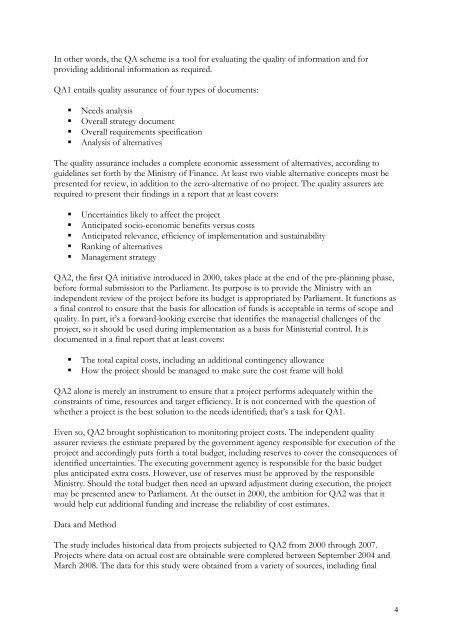Link to thesis. - Concept - NTNU
Link to thesis. - Concept - NTNU
Link to thesis. - Concept - NTNU
- No tags were found...
Create successful ePaper yourself
Turn your PDF publications into a flip-book with our unique Google optimized e-Paper software.
In other words, the QA scheme is a <strong>to</strong>ol for evaluating the quality of information and forproviding additional information as required.QA1 entails quality assurance of four types of documents:• Needs analysis• Overall strategy document• Overall requirements specification• Analysis of alternativesThe quality assurance includes a complete economic assessment of alternatives, according <strong>to</strong>guidelines set forth by the Ministry of Finance. At least two viable alternative concepts must bepresented for review, in addition <strong>to</strong> the zero-alternative of no project. The quality assurers arerequired <strong>to</strong> present their findings in a report that at least covers:• Uncertainties likely <strong>to</strong> affect the project• Anticipated socio-economic benefits versus costs• Anticipated relevance, efficiency of implementation and sustainability• Ranking of alternatives• Management strategyQA2, the first QA initiative introduced in 2000, takes place at the end of the pre-planning phase,before formal submission <strong>to</strong> the Parliament. Its purpose is <strong>to</strong> provide the Ministry with anindependent review of the project before its budget is appropriated by Parliament. It functions asa final control <strong>to</strong> ensure that the basis for allocation of funds is acceptable in terms of scope andquality. In part, it’s a forward-looking exercise that identifies the managerial challenges of theproject, so it should be used during implementation as a basis for Ministerial control. It isdocumented in a final report that at least covers:• The <strong>to</strong>tal capital costs, including an additional contingency allowance• How the project should be managed <strong>to</strong> make sure the cost frame will holdQA2 alone is merely an instrument <strong>to</strong> ensure that a project performs adequately within theconstraints of time, resources and target efficiency. It is not concerned with the question ofwhether a project is the best solution <strong>to</strong> the needs identified; that’s a task for QA1.Even so, QA2 brought sophistication <strong>to</strong> moni<strong>to</strong>ring project costs. The independent qualityassurer reviews the estimate prepared by the government agency responsible for execution of theproject and accordingly puts forth a <strong>to</strong>tal budget, including reserves <strong>to</strong> cover the consequences ofidentified uncertainties. The executing government agency is responsible for the basic budgetplus anticipated extra costs. However, use of reserves must be approved by the responsibleMinistry. Should the <strong>to</strong>tal budget then need an upward adjustment during execution, the projectmay be presented anew <strong>to</strong> Parliament. At the outset in 2000, the ambition for QA2 was that itwould help cut additional funding and increase the reliability of cost estimates.Data and MethodThe study includes his<strong>to</strong>rical data from projects subjected <strong>to</strong> QA2 from 2000 through 2007.Projects where data on actual cost are obtainable were completed between September 2004 andMarch 2008. The data for this study were obtained from a variety of sources, including final4
















